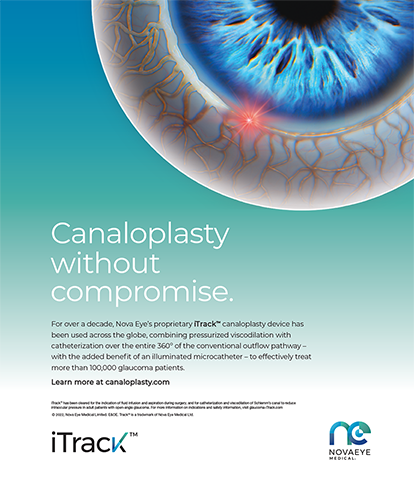Four years ago, I became interested in finding a better treatment for haze after seeing patients who had developed visually significant haze or corneal scarring following RK or PRK. It appeared that patients who were developing scarring after PRK typically had been highly myopic. At first, my colleagues and I attempted to simply debride the haze, but in the majority of cases, it would reappear. We found that removing the scar with adjunctive mitomycin C (MMC) treatment prevented recurrence, and resulted in improved visual acuity.
REMOVING THE SCAR
Because the scar is usually in the anterior, subepithelial portion of the stroma, the first step in eliminating the scar is to remove the epithelium. This can be accomplished by manual debridement, alcohol-assisted removal, or excimer laser ablation set for 45 µm. There are two methods by which to remove the scar. Our initial technique was to manually debride the scar using a pterygium burr to polish the corneal surface. Although this works well, it is a bit crude compared to using the excimer laser itself, in the phototherapeutic keratectomy (PTK) mode, to precisely remove the affected tissue. The concern with PTK, however, is that aggressive central ablation may result in hyperopia. Our technique has evolved to carefully removing the scar in the central 6 mm, and then applying peripheral blending to avoid a significant hyperopic shift. An analogy might be performing PTK in the same fashion that one would remove a central corneal scar in a patient who was essentially emmetropic. I will often move the patient between the excimer laser and the slit lamp a number of times in order to ensure adequate ablation. I don't use a predetermined number of pulses, because this is ultimately determined by the depth of the scar. I may program the laser for the maximum number of pulses, and then use as many or as few as I think I need to accomplish the scar removal and peripheral blending.
SPONGE, IRRIGATE, AND BANDAGE
During the scar removal process, a 6-mm circular sponge (corneal light shield, Mentor, Santa Barbara, CA) (Figure 1) is soaked in a 0.02% MMC solution. Once the scar is removed, I place the sponge on the central cornea for exactly 2 minutes. After removing the sponge, I irrigate the surface of the cornea with 30 mL BSS (Alcon, Inc., Fort Worth, TX) in order to ensure that there isn't any residual MMC on the ocular surface. Then, I either patch the eye with antibiotic ointment, or place a bandage contact lens over the eye. I leave the bandage contact lens on for 3 to 5 days, depending on how quickly re-epithelialization occurs. My colleagues and I haven't found any delay in re-epithelialization in any of the patients we've treated. Some surgeons worry that because MMC inhibits cell division, the epithelial cells won't multiply and repopulate the surface of the cornea appropriately. However, I believe this concern is unfounded. As we know, the cells that are responsible for re-epithelialization are at the limbus, and great care is taken to ensure that MMC is kept away from the stem cells. This supports the observation that re-epithelialization occurs within the normal time frame of 3 to 5 days. I think that surgeons who use MMC for other types of surgery, in which they're administering it near the limbus (where the stem cells and blood vessels are), are probably subject to a higher complication rate because of the location of the MMC application. The location we use on the central cornea is theoretically safer, and we haven't seen any complications, either in patients that we have treated or those who have been treated by a number of ophthalmologists around the world.
PROPHYLACTICALLY SPEAKING
The prophylactic use of MMC is under investigation for actually preventing haze following either PRK or LASEK for high myopia. In these cases, the standard PRK or LASEK technique is performed, and then MMC is applied as mentioned above. The preliminary results of this prophylactic treatment are promising. The current thinking is that the “newer” excimer lasers, as well as LASEK, are incapable of producing significant haze. Interestingly, I recently received an e-mail from someone who had undergone LASEK using one of the “newer” flying-spot lasers, and developed 2+ scarring in both eyes within 3 weeks. Therefore, I don't believe that only the older “broad-beam” lasers can cause haze; I think that it can potentially happen with any of these procedures, and with any excimer laser. Preventive treatment with MMC may prove to be a useful strategy for these patients.
Parag A. Majmudar, MD, is an Assistant Professor of Ophthalmology at Rush Medical College in Chicago, Illinois, and is in private practice with Chicago Cornea Consultants, Ltd. Dr. Majmudar has no financial interest in any product or technology discussed herein. He may be reached at (312) 942-5300; pamajmudar@chicagocornea.com


